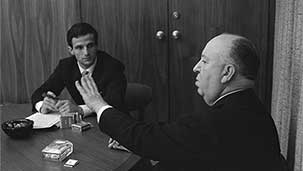About a third of the way through your documentary Hitchcock/Truffaut, the point is made that one of cinema’s strengths is its ability to both slow down and speed up time whenever it fits the filmmaker’s needs. And watching your own film, it struck me that speeding things up is also what you’ve done in this examination of François Truffaut’s seminal study of the works of Alfred Hitchcock. Hitchcock/Truffaut, the film, condenses Truffaut’s book-length interview into a brief (80 minute) overview of the book itself and what it means to its admirers.
Obviously the book’s central conceit – critic-turned-director Truffaut interviewing Alfred Hitchcock in detail about each of his films – clearly spoke to you. And for obvious reasons. As a film critic and essayist, the kind of detailed analysis therein must have been a kind of movie-nerd Nirvana for you, as well as a kind of call to arms. As explained in your film, the book Hitchcock/Truffaut was the publication that finally put Hitchcock’s films on the critical map as Important Works. Before that, his films were seen as popular, well-executed genre pieces, which left them removed from the realm of serious critical discourse. Truffaut's book changed that—not only for Hitchcock, but for film in general. Great art could be found anywhere, even coming out of Hollywood’s factory-like studios.
When it comes to critical examination, you, like Truffaut, subscribe to the auteur theory, which sees the director as the guiding force behind every aspect of a film. And to back that theory up, you’ve assembled a wide-ranging collection of directors to speak on how the book Hitchcock/Truffaut influenced their understandings of cinema as an art form. Watching Martin Scorsese, David Fincher, Wes Anderson, Kiyoshi Kurosawa, Richard Linklater, and a host of others wax nostalgic on their first experiences with Truffaut’s book offers terrific insight into their development as artists. In hindsight, it seems obvious that this is where Fincher learned his laser-focused scene construction, or where Anderson’s love of image composition was born. In a way, their relationship to the book provides some of the same insight that Truffaut’s book does. The simple act of expressing their love for it is a form of (self-)critical analysis.
But it may be that your deference towards directors, not just Truffaut and Hitchcock, gets the better of you in the end. Although Hitchcock/Truffaut’s first half crosscuts between both directors equally, placing them in their own historical and cultural landscapes, the film gradually pushes Truffaut into the background. Instead, Hitchcock/Truffaut starts to seem more like Hitchcock/Scorsese/Fincher/Anderson/Linklater/Kurosawa etc. Hitchcock’s style and technique becomes the focal point, with barely a mention of Truffaut.
I realize this may have been on purpose. Perhaps the strategy was to shift the focus from interviewer to his subject, as Truffaut does in his own book. But as narrator Bob Balaban describes the later careers of both artists, wrapping the film up, I realized that the Hitchcock/Truffaut had become less about the book itself – it’s place in history, its influence on others – and more about Hitchcock’s importance as a filmmaker.
Simply put, it ends up trying to do a job Truffaut’s book already completed almost 50 years ago.
Sincerely,

Casey







